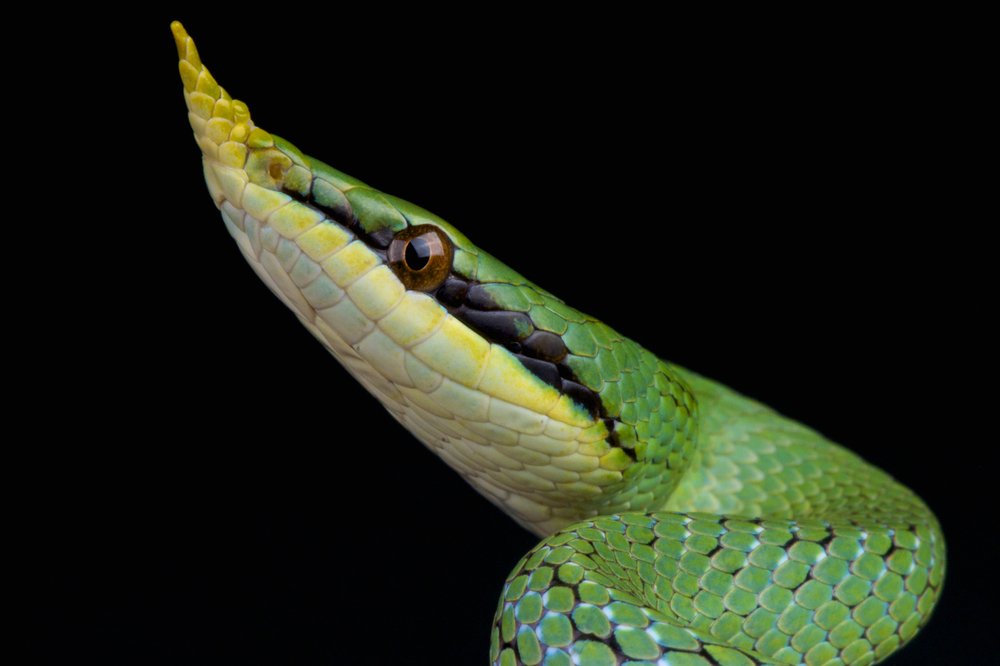The rhino rat snake (Gonyosoma boulengeri) is one of the most unique colubrids on the planet. Found across the tropical valleys of North Vietnam and China, this vibrantly coloured, arboreal rat snake has a prominent scale protrusion on the front of its snout that is still confusing herpetologists.
As a species that is now reasonably well established in zoos and becoming increasingly popular in private collections, herpetologists are just now beginning to understand the complex breeding behaviours of the rhino rat snake. Adam Radovanovic, Head of Reptiles at Birmingham Wildlife Conservation Park was gifted two distinct bloodlines of the species from a few friends several years ago. He has now managed to breed the species for five consecutive years, adding new genetic diversity to UK zoo stock.
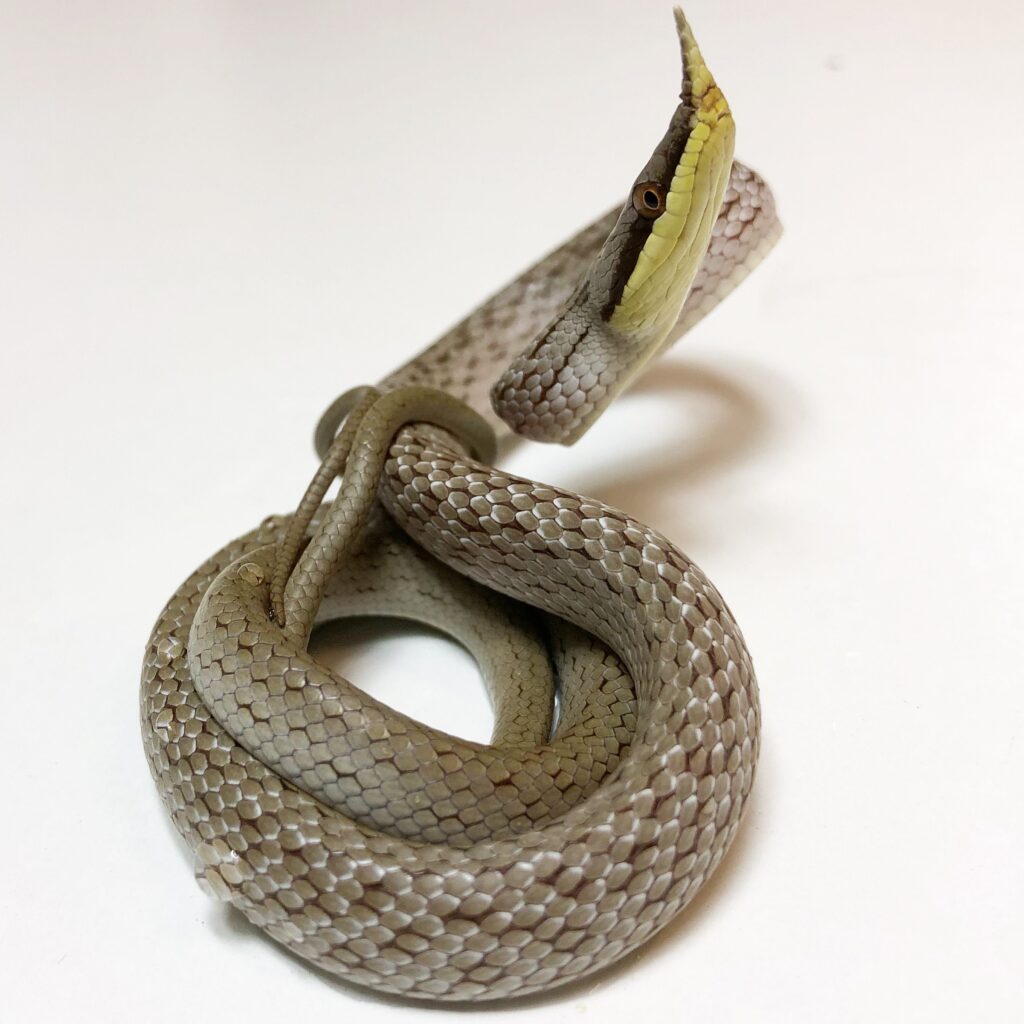
Rhino Rat Snake Breeding Behaviours
Several studies have attempted to discover exactly why the rhino rat snake has such a tremendous horn. Early studies by Bangor University found that it is likely used in mating rituals whereby males will use their horns to fend off rivals. Other reptiles such as the lance-nosed chameleon (Calumma gallus) and the Pinocchio anole (Anolis proboscis) use their scaly protrusions as a signifier of health and vigour which, in turn, gives them a better chance of mating. In the case of the rhino rat snake, studies seem to suggest males will “fence” one another. However, subsequent studies identified little correlation between the protrusion and courtship displays, suggesting that its true use is still unknown.
Both sexes exhibit the rostral horn. It is a soft, fleshy set of scales that protrudes from the snake’s nose. “Although males tend to be larger than females, I haven’t seen any difference in the size of the horn” adds Adam. “In terms of the actual courtship around the enclosure, I haven’t noticed any kind of nuzzling of the female or anything that involves the horn.”
“No one really knows why the rhino rat snake has a horn. Some people think that it’s for drinking. So, when it’s raining the water should run down the nose and into the mouth. But, there are so many other arboreal species that occupy similar habitats that get high precipitation that doesn’t exhibit this sort of evolutionary adaption, so it seems like it’s more to do with camouflage.”
“We keep ficus in the exhibit and you can see that the end of the leaves that drop down into a point, look just like that ornamentation on the nose of a rhino rat snake. I will be looking into the exhibit and honestly, it’s really difficult to find the head! The head looks like a leaf, but the protrusion also looks like a bud. There’s this big umbrella of mystery around the species but it could be something very simple. With the lizards of Sri Lanka, there are multiple uses for all their ornamentation like communication, camouflage, and courtship but it could be something very simple with the rhino rat snake.”
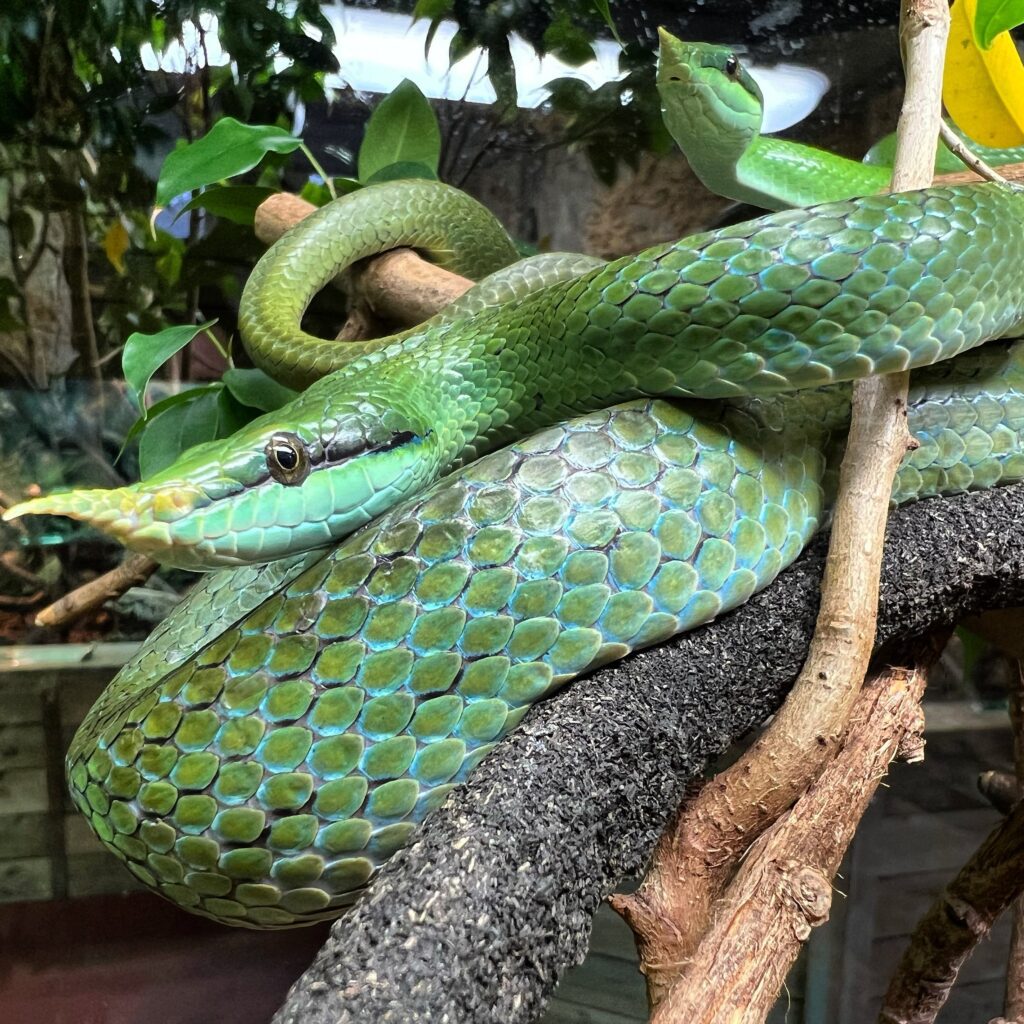
Gonyosoma as a Genus
The rhino rat snake was formerly categorised in a monotypic genus, Rhyncophis. DNA analysis and other herpetological studies now place the species amongst a wide spectrum of neotropical, Asian Colubrids known as “Gonyosoma”. These snakes vary greatly in size and somewhat in appearance but share similar arboreal behaviours. The rhino rat snake’s closest relative is the recently described G. hainanensis (2021), which also possesses a rostral horn but occupies a smaller range in the Hainan Province of China.
Some species of Gonyosoma are also frequently bred in captivity, in both private herpetoculture and within zoos. The red-railed racer (G. oxycephalum) is an extremely widespread species across much of Southeast Asia and as such, has been imported into captivity for decades, with a whole host of different localities and available to the keeper. Adam has also bred red-tailed racers for many years, but has noticed some stark differences between “rhinos” and “red-tails”.
Firstly, the rhino rat snake only lays once a year, whereas other species in the genus (such as the red-tailed racer) can have up to four clutches in a single year. Red-tails are also far hardier, require less fluctuation in temperatures and can tolerate a saturated environment. The rhino rat snake, on the other hand, present more of a challenge to the average keeper and require far more environmental control to thrive within a captive environment.

Rhino Rat Snake Enclosure Design
Birmingham Wildlife Conservation Park houses their pair of animals in a three by three by three-foot enclosure with back access and a mesh roof. The substrate is comprised of coco fibre, soil and fine orchid bark and the entire enclosure is filled with branches, making use of all available space. They use two 2-foot LED strips with a diffuser and a 160W UVB basking lamp that provides UVB and heat in one bulb. This bulb is swapped out with a smaller wattage in the winter months. “Ideally I would like to update the system to halogens and T5’s. As a council zoo, we can’t just change out old systems for new ones and must go through various stages of acceptance, which can be frustrating for us keepers.” Although halogen bulbs cannot be thermostatically controlled, Adam uses a solarmeter and temperature gun to take regular readings. The bulb is positioned above a mesh ceiling in the enclosure, the total UVI received within the basking spot is between 2 and 3. “The enclosure is large enough that the animals can have a basking spot of 35°C but they can move closer to, or further away from this” adds Adam. “In winter, I drop the spot down to around 28°C and at night, all electricals go off, So, in that particular enclosure, it drops right down to 14°C. That is in keeping with southern China and Northern Vietnam and it is a major trigger for them to breed.”
Humidity is also maintained between 60 – 70% with regular spikes up to 100%. Adam continued: “I’ve put sphagnum moss all over the walls so it holds the humidity well. Sometimes they do spend time on the floor so I need to make sure it’s not too wet. They are susceptible to fungal infections. We’ve noticed it and so have other keepers that have kept their animals too wet. The humidity needs to be high but not saturated. While red-tail racers can be saturated without noticing anything but with rhinos you can definitely see some fungal or bacterial infection creep into the ventral scales. Once you ease off on the humidity, it is sloughed out and it looks fine again, but it is something we need to be careful about with this species.”
During the winter period, Adam adjusts the photoperiod slightly, but also uses the natural seasonal changes as a tool to encourage a “cooling down” period. The exhibit is close to the door of the reptile house and therefore receives a lot of visible light from outside as well as the windows within the off-show area behind the exhibit. Both provide some sense of seasonality alongside the gradual reduction of artificial light within the enclosure. “I am absolutely certain that you can change the lighting all you like, but the barometric pressure changes and lighting that’s coming in from outside are picked up upon anyway” claims Adam.
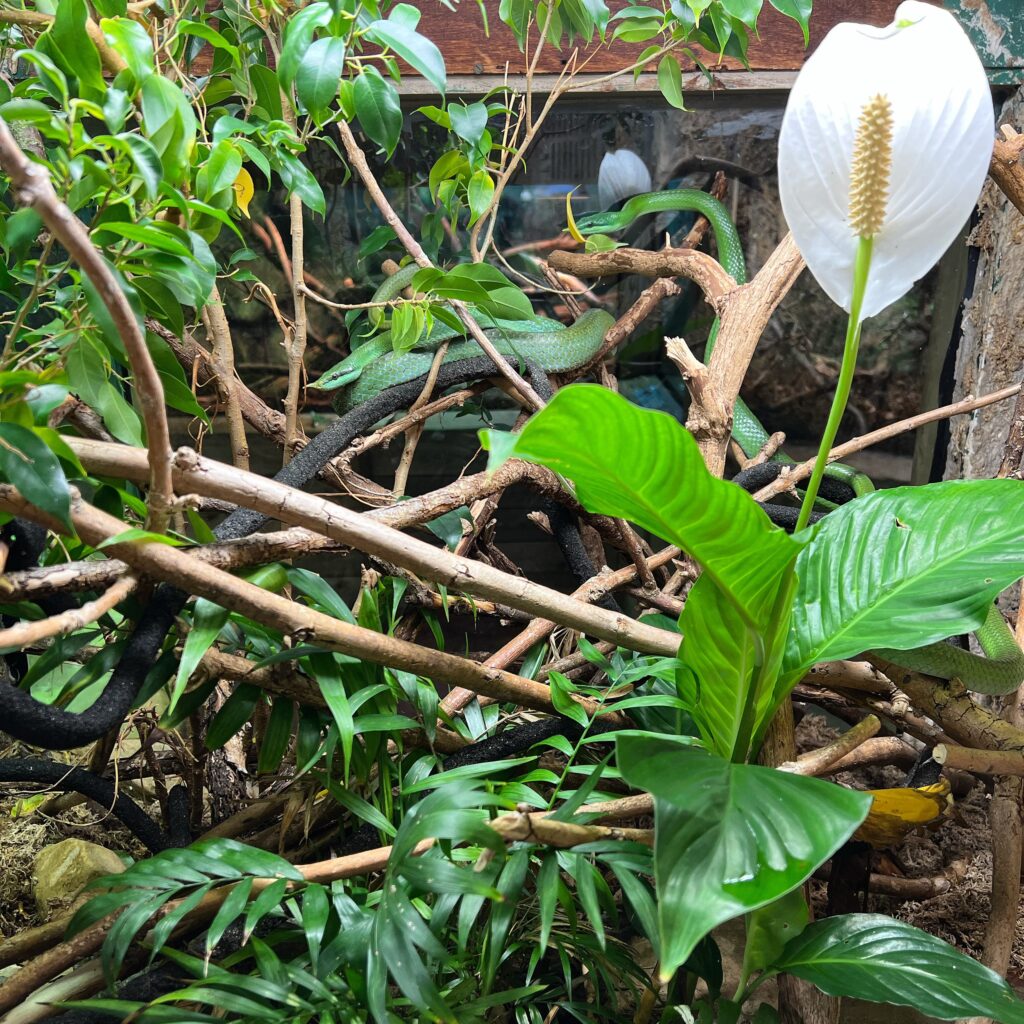
Breeding Rhino Rat Snakes
The two animals were from different bloodlines and were gifted to Adam and are now maintained at the park. This has managed to introduce some new bloodlines into zoo stock. Typically, zoological institutions (particularly those that are involved in wider governing body organisations) cannot simply source animals from private keepers or open imports. This means that over time, the genetic diversity of “zoo stock” becomes limited. Naturally, flagship species with unique lineages become extremely valuable and Adam claims “demand for the rhino rat snake is quite high”, with some of the juveniles going to various zoos and colleges across the country each year.
Adam continued: “I don’t need to separate them at all which is great. This year, the female fed fine so I just keep them both together. I will feed them both adult mice and small quail. You can give them all sorts, fish, amphibians, other reptiles etc but we don’t have access to that so we switch it up with quail. During winter I’ll give them perhaps one adult mouse or a quail chick once a month. Once they’ve warmed up I’ll feed them perhaps once every 7 – 10 days. My regimes are very sporadic, sometimes I’ll leave them for three weeks or a month. I am just constantly body-scoring the animals. Not just the rhinos, but everything really.”
Mating usually begins in late April for the rhino rat snake. After a reasonably short gestation period of 55-60 days, the eggs are laid, typically in late June. Like (presumably) all snakes, the rhino rat snake will do a pre-lay slough, which is a good indicator that they will soon produce eggs. “We’ve recorded that after their pre-lay slough, it can be anything from 8 to 20 days before she decides to lay” adds Adam. “For indigo snakes, for example, I’ve pretty much got it down to like 19 days exactly. Other snakes will slough and you’ll get eggs two days later. With rhinos, it does vary quite a bit!”
“Around the sloughing period, they will spend a little more time on the ground. I’m not sure if they do this in the wild, or whether it’s just uncomfortable for the snakes to be on the branches at this time but we’ve noticed the females coming down to the floor and even getting under the substrate. We use a smaller water bowl around this time. !’ve heard from other breeders that the snakes will try to lay their eggs in the water bowl if it’s soo large, so we swap it out to a smaller one just in case. I have noticed they will wrap around the bowl, which is a good indicator to swap it out.”
“A rhino rat snake will coil around its eggs and remain with their clutch until the keeper removes them. Unlike pythons, they form a loose coil when guarding their eggs which Adam describes as “almost pretzel-y”. “They show no aggression while they are coiling their eggs and don’t get defensive when you take the eggs away, which is something you do get with pythons. But, they do get very defensive afterwards. At this point it’s really important to clean the entire enclosure, remove the smell of the eggs, by replacing the substrate and get back to a normal routine to help the females relax.”
“I’ve never left the eggs in long enough to see exactly why, but I have noticed that rhino rat snakes do, sort of, muscular shivers after they have laid. This usually stops after a few days and one month later, the post-lay slough will take place and she’ll be brand new. The rhino rat snake in general, sloughs VERY infrequently compared to other snakes! Even babies will slough very irregularly. Babies can go three months without sloughing at all! Most baby snakes will slough every few weeks.”
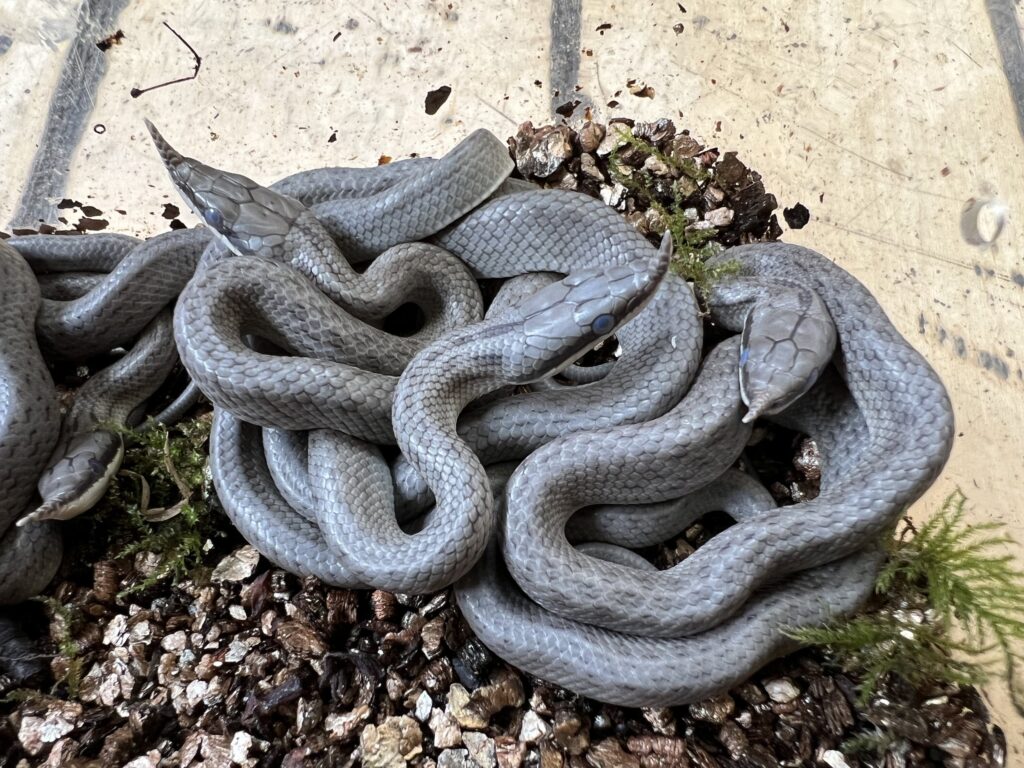
The Incubation Process
Eggs are laid in clumps and can be incubated either as one large clump or separated and incubated as separate eggs. “I’ve incubated them in both ways and they’re usually really good. Even if an egg in the centre of a clump goes bad, it rarely affects the rest of the clutch. However, they can be separated, unlike red tail racer eggs which are honestly like they’ve been glued together. After a clutch has hatched, I’ve tried to separate the racer eggs and it’s impossible to separate them.”
“I’ve witnessed them dropping the eggs from the top of the branches, about 2 foot in the air. I have no idea why they do this but I’ve been stood there with my arms out and some soft moss under the snake’s cloaca ready to catch the eggs before. That was quite frustrating because nothing had changed from a husbandry point of view and we even had really good success rates with most the eggs but a percentage of the ones that were dropped seemed to fail part way through incubation.”
There are numerous ways to incubate a clutch of snake eggs, but Adam opts for using an airtight box, set at 27°C (never higher) and exchanges oxygen every few days. “I incubate in two ways. Sometimes I’ll use vermiculite with sphagnum moss around the edge. This lets you keep the moss wet without having to oversaturate the vermiculite. I’ve also incubated over egg-crate. The best thing about that is you don’t have to worry about putting too much water in there. It’s when the keeper starts faffing and thinking ‘I haven’t put enough water in there’ that problems start happening with incubation.”
Rhino rat snake incubation periods are short. After around 55 – 56 days, the hatchlings will emerge from their clutch. Health checks are necessary to ensure that the development process has been successful. Arboreal snakes are particularly susceptible to tail kinks, so it is important to do a thorough check. “Skeletal problems are possibly influenced by temperature and haven’t found any since incubating at that lower temperature” adds Adam.
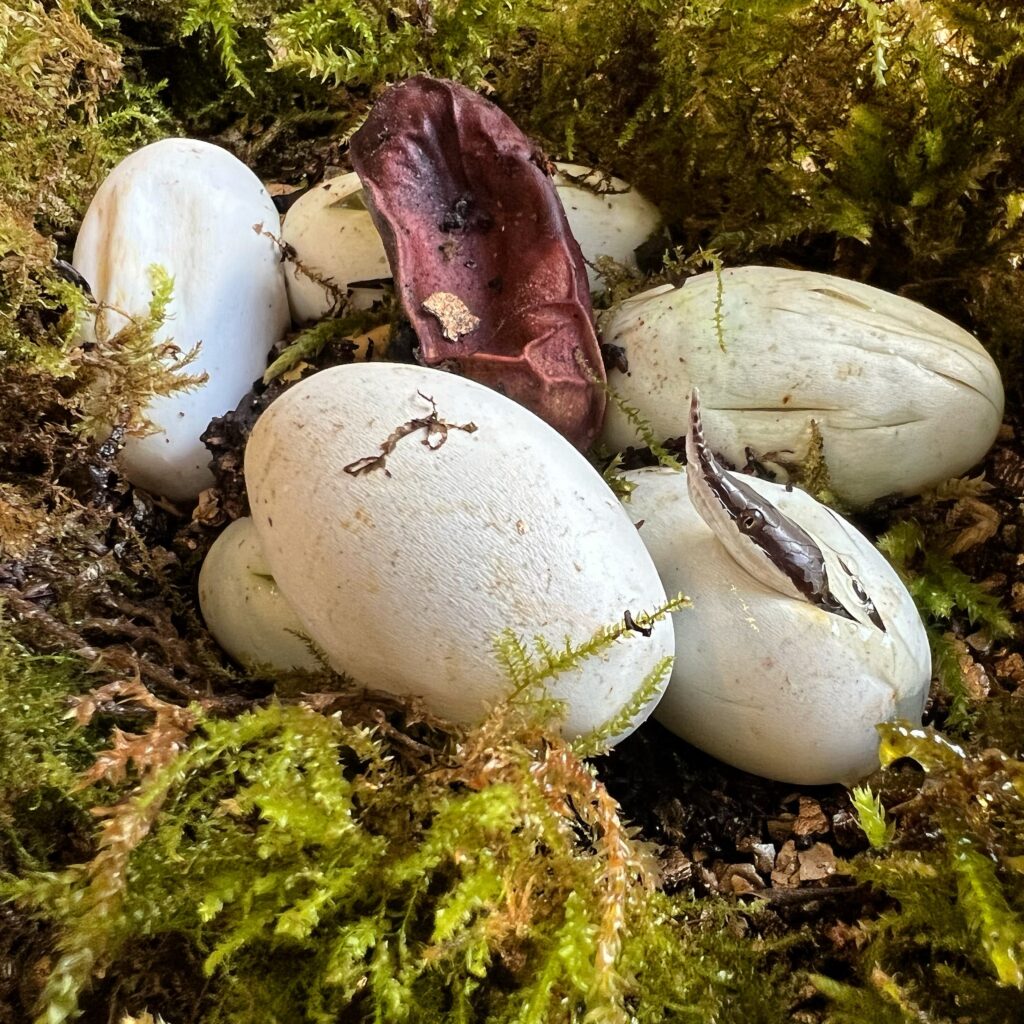
Baby Rhino Rat Snakes
The youngsters are kept in small terrariums with a small UV tube (that provides 1.5 – 2 UVI) and a few bamboo poles to give them the option to climb. Adam continued: “The babies probably spend 50/50 of their time on the ground and climbing. Sometimes they’re up on the branches, other times they’re buried in the moss. We also add a water bowl that they can completely submerge in, which they will tend to do after a feed. I’m not sure whether it’s the weight of the food in the stomach, but they certainly head to the water and bathe for a day or two after their food.”
Rhino rat snakes are notoriously difficult feeders, particularly when they are young. Many keepers will opt to use easily digestible foods such as mouse tails or pinkie heads. Scenting with fish or amphibian scents can also encourage feeding in slightly older individuals. If all else fails, assist-feeding is an option that keepers may have to resort to. “Sometimes it can take a while to get them to feed” explains Adam. “But, they are quite defensive as juveniles which can be an advantage to the keeper. You can almost wind them up until they strike at the food, and then you play musical statues until they take it and swallow it. Sometimes I feed them while holding them with one hand and feeding the pinky in the other. This way they grab it and hold on to it in mid-air. I’ve always used that technique for red-tailed racers and it works a treat. If you just leave the pinky in the enclosure, it’s just not going to work.”
After about a year of rearing the youngsters, they will go through an ontogenetic colour change. The greyish-silver juveniles will begin turning into their uniform green colouration around this time and will soon begin exhibiting more “adult” rhino rat snake behaviours.
The juveniles that have been produced at Birmingham Wildlife Conservation Park have been instrumental in improving colective knowledge of the rhino rat snake and provide a valuable tool to teach the public about unusual reptiles. While their mysterious horn may be a rather underwhelming punt at camouflage, their spectacular appearance allows the species to represent the “weird and wonderful” within zoological collections, generating conservation interest for a group of animals often maligned within zoos.
